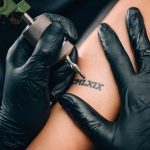Three-dimensional tattoos offer a new alternative for creating a natural-looking nipple after breast reconstruction. For most women, accessing this option means finding a tattoo artist with the skill to create these detailed tattoos. Now a new device called Nipple By Number® enables plastic surgeons to perform realistic-looking 3D nipple tattoos as an in-office procedure, reports a paper in the January issue of Plastic and Reconstructive Surgery®, the official medical journal of the American Society of Plastic Surgeons (ASPS).
Nipple by Number® is a simple stencil device that allows consistent, realistic 3D tattooing of the nipple-areola complex [NAC] to complete breast reconstruction. It allows plastic surgeons to perform this sought-after procedure in a safe, reliable, and more- affordable manner, without the need for special training or experience."
Solomon Azouz, MD, lead author of Mayo Clinic Arizona, Scottsdale
For most patients, mastectomy results in loss of the NAC – the nipple and surrounding tissue. Breast reconstruction has important benefits after mastectomy, but the surgical options for NAC reconstruction are limited.
In recent years, 3D breast tattoos have emerged as a new approach to creating a natural-appearing nipple and areola. Developed by skilled tattoo artists, these techniques use subtle effects of light and shadow to create realistic-looking 3D NAC tattoos.
But 3D nipple tattoos may be difficult to access for most patients. Relatively few artists can perform these sophisticated tattoos. Patients and surgeons may have concerns about verifying the artist's skill, or about visiting a tattoo parlor to have the procedure performed. In a survey, Dr. Azouz and colleagues found that less than one-fourth of plastic surgery offices can perform 3D nipple tattoos, or even refer patients to a qualified tattoo artist. National average out-of-pocket costs range from $640 for unilateral to $956 for bilateral breast tattoos.
The Nipple By Number device was developed to provide plastic surgeons with a way of performing 3D nipple tattoos as an office procedure. Itself created by 3D printing, the simple device consists of removeable stencil layers with customizable holes to provide a guide for well-controlled and precise tattooing.
"The device allows a more facile and efficient approach by allowing those not skilled in the freehand artistic techniques of light and shadow to create a 3D recreation of the NAC," Dr. Azouz and coauthors write. The stencil includes openings to guide placement of highlights and shadows to create the illusion of a projecting nipple, and even the tiny Montgomery glands surrounding the nipple. In patients whose reconstruction includes a raised nipple, the device can also be used to create "4D" tattoos.
Women have the natural appearance of their nipple restored based on preoperative photographs, or choose from a catalog of NAC designs. The authors note that the Nipple By Number device not only provides a guide for performing tattoos, but may also shorten the learning curve for surgeons or other professionals to gain the technical and artistic skills needed to provide high-quality results with 3D nipple tattooing.
Dr. Azouz and colleagues hope their tool will help make the option of 3D nipple tattooing more widely available to women who have undergone breast reconstruction. The authors conclude: "The Nipple By Number device will decrease the number of patients who are left to independently find a safe and skilled tattoo artist to complete their breast reconstruction and aid more plastic and reconstructive surgery practices in providing this important service."


